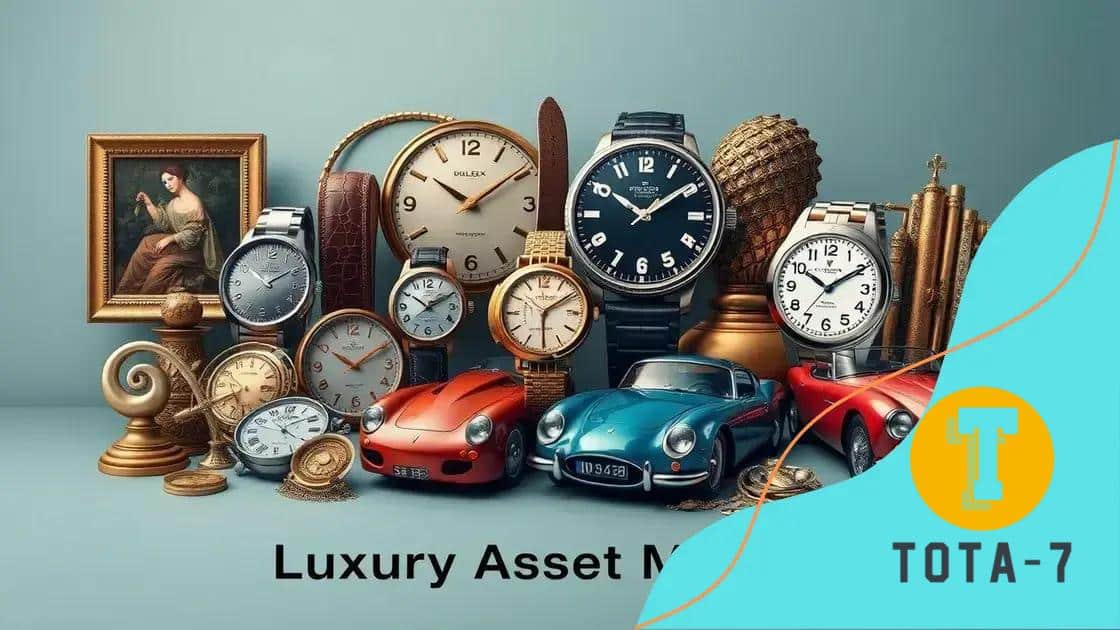Fractional investing expands to luxury asset markets

Fractional investing expands to luxury asset markets by allowing multiple investors to own shares of high-value assets like real estate, fine art, and classic cars, making prestigious investments accessible to a broader audience.
Fractional investing expands to luxury asset markets, creating exciting opportunities for everyday investors. But what does this mean for you? Imagine owning a slice of a multi-million-dollar yacht or fine art without breaking the bank. Let’s dive into this fascinating investment trend.
Understanding fractional investing
Understanding fractional investing is essential for anyone looking to diversify their portfolios with luxury assets. This investment method allows individuals to own a smaller portion of high-value assets, making investing accessible to more people. With fractional investing, you can join forces with other investors to share the costs of expensive items, such as real estate, fine art, or collectibles.
How does fractional investing work?
In fractional investing, a company typically manages the asset, allowing multiple investors to buy a share. Each investor owns a percentage of the asset, receiving both part of the potential profits and the associated risks. This approach reduces the barrier to entry for high-end investments that would otherwise be out of reach for many.
Key benefits of fractional investing
There are several advantages to fractional investing:
- Access to expensive assets without needing a large sum of money.
- Diversification of investments across various luxury markets.
- The opportunity to explore different types of assets that may appreciate in value over time.
For example, consider luxury real estate investments. Traditionally, investing in property requires a substantial upfront payment. However, with fractional investing, a buyer can invest a smaller amount while still reaping benefits from property appreciation and rental income. This makes luxury assets more attainable.
Additionally, fractional investing opens doors for users to explore different industries and sectors they might not have considered before. It further enhances their portfolio’s resilience against market volatility.
Risks and considerations
While fractional investing offers numerous benefits, it’s crucial to remain aware of potential risks. These can include:
- Market risks associated with the luxury asset class.
- Liquidity concerns, as it may not be easy to sell your shares.
- Management fees imposed by the company managing the asset.
Understanding these factors can help investors make informed decisions about their investments. By weighing the pros and cons, investors can strategically incorporate fractional investing into their financial plans.
Growth of luxury asset markets

The growth of luxury asset markets has been remarkable in recent years, making this an exciting area for investors. With more people seeking unique investments, the market for high-end items has exploded, allowing fractional investing to flourish. People are now more aware of the benefits that luxury assets can bring to their portfolios.
Factors driving market growth
Several key factors contribute to the expansion of luxury asset markets:
- Increased wealth among individuals worldwide.
- Growing interest in alternative investments.
- Rising demand for exclusive items, such as fine art and vintage cars.
As society develops, the mindset surrounding investments is also changing. Many consumers no longer view luxury items simply as status symbols. Instead, they recognize their potential for appreciation over time, further fueling the market growth.
The impact of technology
Technology has played a significant role in supporting the growth of luxury asset markets. Online platforms now provide investors with easy access to high-end items. They can view and purchase assets at their convenience, without geographic limitations. This accessibility caters to a broader range of investors, making luxury assets more attainable than ever.
Moreover, technology has improved the transparency of these markets. Investors can now evaluate the authenticity and value of items before making decisions. This data-driven approach supports informed choices, helping to build trust among buyers.
Emerging trends in luxury investing
Several trends are reshaping luxury investing:
- Increased interest in sustainable luxury products.
- The rise of digital art and NFTs as valuable collectibles.
- Shifts towards experiences over material possessions.
As more people prioritize sustainability and personal experiences, luxury asset markets will continue to evolve. Investors must stay informed and adapt to these new trends as they develop.
Benefits of fractional investing in luxury assets
The benefits of fractional investing in luxury assets are numerous, making it an attractive option for many investors. By allowing individuals to own a fraction of valuable items, this investment method creates opportunities that are otherwise inaccessible to most. Whether it’s fine art, classic cars, or exclusive vacation properties, fractional investing makes high-end assets available to a broader audience.
Cost-effective ownership
One major advantage of fractional investing is cost-effectiveness. Investors can participate in luxury markets without needing a large sum of money upfront. Instead of buying an entire asset, they only need to buy a percentage. This significantly lowers the barrier to entry.
Diversification of assets
Another important benefit is diversification. Fractional investments enable individuals to spread their money across various luxury assets. This reduces overall risk since different asset classes can perform differently in changing market conditions. For example, if one asset decreases in value, others may increase.
- Investors can own a share of luxury real estate, fine art, and vintage cars simultaneously.
- This diversification helps minimize risk, especially during economic downturns.
- It allows for a more balanced investment portfolio.
The ability to invest in different asset types also fosters engagement. Investors often find joy in learning about various luxury sectors, enhancing their appreciation of art, culture, and historic items.
Shared responsibilities and management
Fractional investing often means shared responsibilities among investors. Many platforms handle the management of luxury assets, relieving individual investors of this burden. This arrangement allows them to focus on their investments without dealing with the complex details of ownership.
Furthermore, being part of a larger group can create a sense of community. Investors may connect with others who share similar interests in luxury markets, enhancing the experience.
Common types of luxury assets available

Understanding the common types of luxury assets available is crucial for anyone interested in fractional investing. These assets can offer a unique opportunity to diversify investments while enjoying the prestige that comes with luxury items. Let’s explore some popular categories of luxury assets.
Luxury Real Estate
Luxury real estate is one of the most sought-after forms of investment. Properties in prime locations often appreciate over time, making them attractive to investors. Whether it’s a beachfront villa or a penthouse in a bustling city, fractional investing allows multiple investors to own a share in these high-value properties.
Fine Art
Investing in fine art is another exciting opportunity. Many investors purchase art not just for enjoyment but also as a potential investment. The value of artworks can increase significantly, especially pieces from renowned artists. Through fractional investing, individuals can own a part of prestigious collections that might otherwise be out of reach.
- Investors can gain access to masterpieces from famous artists.
- Art can serve as a hedge against inflation.
- Due diligence on provenance and authenticity enhances value.
Classic Cars
Classic cars are not just vehicles but valuable collectibles and investments. Some vintage cars appreciate in value as they become rarer over time. Fractional ownership allows car enthusiasts to invest in legendary models without the hefty upfront costs of full ownership.
Watches and Jewelry
Luxury watches and fine jewelry also make excellent investments. Well-known brands often maintain or increase their value over time, making them popular among collectors. Fractional investing provides a pathway for individuals to own shares in valuable pieces.
Investing in luxury assets can help diversify an investment portfolio, providing both financial returns and personal enjoyment. As the market for luxury assets continues to grow, opportunities for fractional investing will likely expand, making these assets more accessible to a wider audience.
How to get started with fractional investing
If you’re wondering how to get started with fractional investing, you’re not alone. Many people are eager to enter this exciting world of high-value assets without the need for huge upfront costs. Here are some steps to help you begin your journey into fractional investing.
Research Investment Platforms
The first step is to research various investment platforms that offer fractional investing options. Look for platforms that specialize in luxury assets, such as real estate, art, or collectibles. Read reviews and compare fees and services to find the one that fits your needs the best.
Create an Account
Once you’ve selected a platform, you can create an account. This process usually involves providing some personal information, such as your name, email address, and financial details. Be prepared to go through identity verification to ensure the security of your account.
Assess Your Budget
Before making any investments, assess your budget to determine how much you can afford to invest in fractional assets. Decide if you want to invest a lump sum or spread your investments over time. Understanding your financial situation will help you make informed decisions.
- Consider setting a monthly investment goal.
- Don’t invest more than you can afford to lose.
- Prioritize diversification to minimize risk.
It’s crucial to approach fractional investing with a clear strategy to maximize returns while managing risk.
Explore Available Assets
Next, explore the range of assets available through your chosen platform. Look for luxury real estate projects, fine art collections, or unique collectibles that interest you. Take your time assessing different options and read the details about each opportunity.
Make Your First Investment
When you’re ready, it’s time to make your first investment. Select the asset you wish to invest in and review the terms before proceeding. Many platforms allow you to start with smaller amounts, making it easier to dip your toes into the market. Once your investment is confirmed, you’ll start to see how fractional ownership works.
As you gain experience, consider expanding your portfolio to include different asset types. This not only reduces risk but also increases the potential for returns as various markets perform differently. Fractional investing can be a rewarding way to build wealth over time.
FAQ – Frequently Asked Questions about Fractional Investing
What is fractional investing?
Fractional investing allows multiple investors to own a small percentage of high-value assets, making luxury investments accessible to more people.
How can I get started with fractional investing?
To start, choose a reputable investment platform, create an account, set a budget, and explore the available luxury assets to invest in.
What are some common types of luxury assets I can invest in?
You can invest in various types of luxury assets, including real estate, fine art, classic cars, and luxury watches.
What are the benefits of fractional investing?
The benefits include lower investment costs, diversification of assets, shared responsibilities in management, and the opportunity to invest in high-value items.





